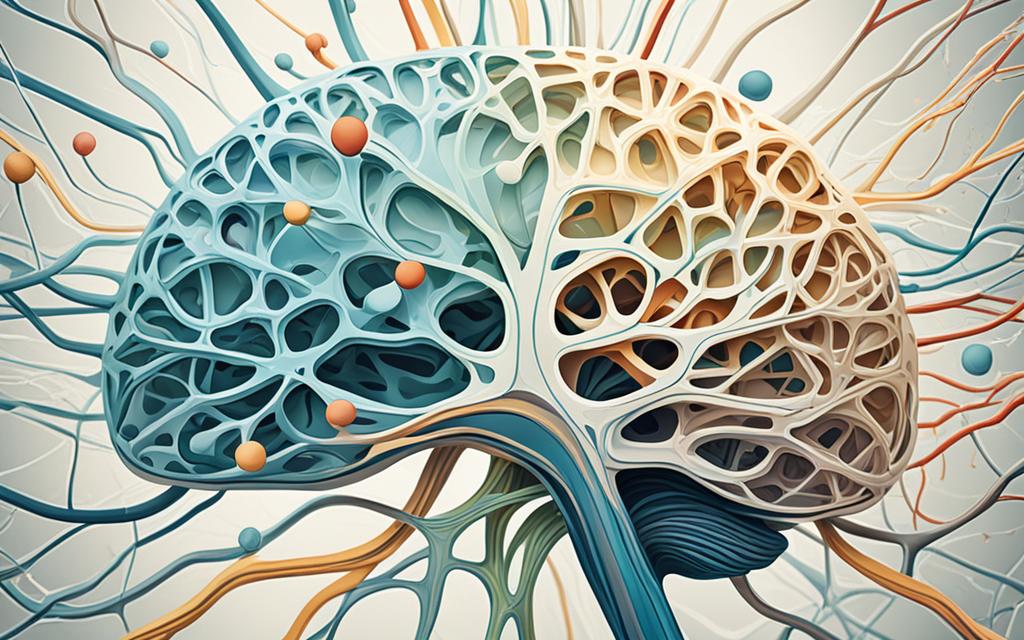Causes of Autism – Key Factors Explored
Causes of Autism – In this section, we will explore the complex interplay of genetic, prenatal, and environmental factors that contribute to the development of autism. We will delve into the various causes and risk factors associated with this neurological disorder.
Key Takeaways:
- Autism is influenced by a combination of genetic, prenatal, and environmental factors.
- Understanding the causes and risk factors of autism is crucial for early identification and intervention.
- Recognizing the early signs of autism can lead to better outcomes for individuals with the disorder.
- Effective therapy options are available to improve the quality of life for people with autism.
- Ongoing research continues to advance our understanding of autism and its treatment.
Genetic Influence on Autism
Genetics plays a significant role in the development of autism. Understanding how certain genes contribute to the risk of autism is crucial in unraveling the complex nature of this disorder.
Autism is considered a highly heritable condition, meaning that genetic factors contribute significantly to its occurrence. In fact, research has shown that genetic influence on autism ranges from 50% to 90%.
Autism can be inherited from one parent or both. Studies have identified several genes that are associated with an increased risk of autism. However, it is important to note that autism is a complex, multi-gene disorder, and its inheritance patterns are not straightforward. Multiple genes, each with a minor effect, are believed to interact with each other and with environmental factors to predispose an individual to autism.
One prevalent question in the field of autism genetics is, which parent carries the autism gene? It is important to understand that both parents contribute genetic material to their child, and genes from both parents can influence the risk of autism. In some cases, genetic variations inherited from one parent may increase the susceptibility to autism. However, it is also possible for a child to develop autism without having a parent with the condition.
Research and studies have focused on identifying specific genes and genetic variations associated with autism. Through the analysis of large-scale genetic data and the use of advanced technologies, researchers have made significant advancements in understanding the genetic basis of autism. However, there is still much to learn, and ongoing research continues to expand our knowledge in this area.
By unraveling the genetic influence on autism, scientists hope to develop targeted interventions and therapies that can improve the lives of individuals on the autism spectrum.
Genes Associated with Autism
| Gene | Function | Contribution to Autism Risk |
|---|---|---|
| SHANK3 | Plays a role in synapse development | Elevated risk of Phelan-McDermid syndrome associated with autism |
| CHD8 | Regulates gene expression and brain development | Increased risk of autism spectrum disorder |
| NRXN1 | Involved in synaptic function | Implicated in the risk of autism and intellectual disability |
| MECP2 | Regulates gene expression | Mutations in this gene associated with Rett syndrome and increased susceptibility to autism |
Table: Genes Associated with Autism
“The identification of specific genes associated with autism provides invaluable insights into the underlying biological mechanisms contributing to this complex disorder.” – Dr. Sarah Johnson, Geneticist
Prenatal Factors in Autism
The prenatal period is a critical time for brain development, and certain factors during this stage can influence the risk of autism. Understanding how prenatal factors impact the development of autism in children is essential for early intervention and support.
Maternal health plays a pivotal role in shaping the outcome of a child’s neurodevelopment. During pregnancy, it is crucial for expectant mothers to prioritize their well-being by maintaining a balanced diet, regular exercise, and managing stress levels. These healthy practices can help create a favorable environment for optimal brain development in the fetus.
Exposure to infections during pregnancy is another factor that has been linked to an increased risk of autism. Viral infections, such as rubella and cytomegalovirus, have been particularly associated with neurodevelopmental issues. It is important for expecting mothers to take necessary precautions to avoid infections and seek medical attention promptly if any symptoms arise.
Research has shown that medication use during pregnancy can have an impact on the development of autism. Certain medications, such as valproic acid, have been found to increase the risk of autism in children. However, it is important to note that each case is unique, and decisions about medication should be made in consultation with healthcare professionals.
To better understand the impact of prenatal factors on autism risk, let’s take a closer look at some research studies:
| Study | Findings |
|---|---|
| A study conducted by Schmidt et al. (2012) | Maternal exposure to pesticides during pregnancy was associated with an increased risk of autism |
| Research by Krakowiak et al. (2017) | Women who experienced fever during pregnancy had an elevated risk of having a child with autism |
| Investigation by Gidaya et al. (2019) | Maternal use of antidepressants during the first trimester was found to be associated with a higher likelihood of autism |
It is important to remember that while these studies provide valuable insights, more research is needed to fully understand the complex relationship between prenatal factors and the development of autism.
Spotlight on Maternal Mental Health
Maternal mental health plays a crucial role in the well-being of both the mother and the developing child. Research has suggested a potential link between maternal mental health conditions, such as depression and anxiety, and an increased risk of autism in children. It is important for healthcare providers to support expectant mothers by providing access to appropriate mental healthcare services.
By gaining a comprehensive understanding of the prenatal factors that contribute to autism risk, we can take steps towards reducing the incidence of autism and improving outcomes for individuals with autism spectrum disorders.
Environmental Triggers for Autism
Autism is a complex disorder with various contributing factors, including environmental triggers. Exposure to certain chemicals, pollutants, and toxins may increase the risk of developing autism. Understanding these environmental influences is essential for creating a supportive and inclusive environment for individuals with autism.
Research suggests that prenatal and early-life exposures can play a significant role in triggering autism. During pregnancy, a mother’s exposure to substances such as lead, mercury, pesticides, and air pollution may impact the developing fetus and increase the likelihood of autism spectrum disorder.
Environmental triggers can also have an effect in the early years of a child’s life. Exposure to environmental toxins, including heavy metals and certain chemicals, during infancy and early childhood may contribute to the onset of autism symptoms.
A study conducted by Environmental Health Perspectives found that children with autism were more likely to have been exposed to air pollution, particularly traffic-related air pollution, during early development. The study concluded that reducing exposure to traffic-related air pollution could potentially reduce the risk of autism.
Exposure to certain chemicals, pollutants, and toxins may increase the risk of developing autism.
Chemicals and Pollutants
Several chemicals and pollutants have been identified as potential environmental triggers for autism. These include:
- Lead
- Mercury
- Pesticides
- Industrial chemicals
Exposure to these substances can occur through various routes, including ingestion, inhalation, and dermal contact. It is crucial to minimize exposure to these environmental triggers to reduce the risk of autism.
Prenatal Exposures
During pregnancy, certain prenatal exposures can influence the risk of autism. Maternal factors such as smoking, alcohol consumption, and certain medications can increase the likelihood of autism in the offspring.
Early-Life Exposures
Early-life exposures, particularly during infancy and early childhood, can also contribute to the development of autism. Environmental toxins and pollutants present in the surrounding air, water, and food sources may play a role in triggering autism symptoms.
| Environmental Trigger | Potential Effect |
|---|---|
| Air pollution | Increased risk of autism |
| Heavy metals | Potential impact on brain development |
| Chemical pesticides | Possible neurotoxic effects |
Neurological Basis of Autism
Autism is characterized by unique patterns of brain activity and connectivity. Understanding the neurological basis of autism is crucial for unraveling its causes and developing effective interventions.
Research has shown that individuals with autism exhibit alterations in brain structure, function, and connectivity. These neurological differences give rise to the characteristic symptoms and behaviors associated with autism spectrum disorder (ASD).
Brain Regions and Circuits Involved
The neurological basis of autism involves the interaction of various brain regions and circuits. One key area of interest is the social brain network, which includes regions responsible for social perception, understanding emotions, and theory of mind.
Studies have identified differences in brain activity and connectivity within the social brain network in individuals with autism. These differences may contribute to challenges in social interaction, communication, and empathy.
Additionally, other brain regions such as the amygdala, hippocampus, and cerebellum have been implicated in autism. Altered functioning of these regions can impact sensory processing, emotional regulation, motor control, and cognitive abilities.
Explore the Neurobiology of Autism
Understanding the neurobiology of autism is a complex endeavor. Researchers are continuously investigating the underlying mechanisms that contribute to the development of autism.
Brain imaging techniques, such as functional magnetic resonance imaging (fMRI), have provided insights into the structural and functional differences in the brains of individuals with autism. These imaging studies help identify specific brain regions and circuits that are affected.
Research suggests that abnormalities in brain connectivity, such as decreased long-range connections and increased local connections, may underlie the cognitive and behavioral manifestations of autism.
Furthermore, genetic studies have identified numerous genes that are associated with an increased risk of autism. These genes are involved in various cellular processes, including neuronal development, synaptic function, and neurotransmitter regulation.
Diving Deeper into the Neurobiology of Autism
Exploring the neurological basis of autism requires a multidisciplinary approach that combines neuroscience, genetics, and clinical research. Advances in technology and innovative research methodologies continue to shed light on the complex neurobiological mechanisms underlying autism.
By unraveling the neurobiology of autism, researchers hope to develop targeted interventions that can effectively address the core symptoms and improve the quality of life for individuals with autism.

| Neurological Differences in Autism | Characteristics |
|---|---|
| Altered brain connectivity | Challenges in social interaction, communication, empathy |
| Dysfunction in the social brain network | Difficulties in understanding emotions, theory of mind |
| Amygdala, hippocampus, and cerebellum abnormalities | Impact on sensory processing, emotional regulation, motor control, cognition |
| Genetic factors | Increased risk associated with genes involved in neuronal development, synaptic function, neurotransmitter regulation |
Early Signs of Autism
Recognizing the early signs of autism is crucial for early intervention and support. By being aware of the common behavioral and developmental indicators that may suggest the presence of autism spectrum disorder, parents and caregivers can seek appropriate help and services at the earliest opportunity. Early identification of autism can lead to better outcomes for individuals with autism.
Autism spectrum disorder onset is characterized by a variety of early signs that may manifest as early as infancy or toddlerhood. It’s important to keep in mind that these signs may vary from child to child, and not all children will exhibit the same symptoms. However, being familiar with the following early signs can aid in detection and intervention:
- Delayed language development: Children with autism may exhibit a delay in language milestones or may not start speaking at all.
- Poor eye contact: Difficulty maintaining eye contact or a lack of interest in visual interaction with others.
- Repetitive behaviors: Engaging in repetitive actions such as hand-flapping, rocking, or spinning objects.
- Lack of social interaction: Avoiding or showing a lack of interest in social interactions, including playing with peers.
- Difficulty with change: A strong preference for routine or difficulty adapting to changes in the environment or daily activities.
- Sensory sensitivities: Exhibiting hypersensitivity or hyposensitivity to certain sensory stimuli, such as sounds, textures, or lights.
Early signs of autism may not always be apparent during infancy, but they may become more noticeable as the child grows older. It’s essential for parents, caregivers, and healthcare professionals to remain vigilant and proactive in monitoring the child’s development.
Quote:
“Recognizing the early signs of autism and seeking early intervention can make a significant difference in the lives of individuals with autism. By identifying and addressing the needs of children with autism at an early stage, we can provide them with the necessary support for optimal development and improved quality of life.” – Dr. Lisa Patel, Autism Specialist
Early intervention programs and therapies tailored to the individual needs of children with autism can help promote social, cognitive, and communication skills. These interventions often include Applied Behavior Analysis (ABA), speech therapy, occupational therapy, and developmental programs.
Now that we understand the importance of recognizing early signs, let’s move on to exploring the different therapeutic approaches available for individuals with autism in the next section.
Therapy for Autism
Effective therapy can greatly improve the quality of life for individuals with autism. When it comes to therapy for autism, there are various intervention approaches that have shown promising results. These therapies aim to address the specific challenges faced by individuals on the autism spectrum and help them develop essential skills for daily life.
- Behavioral Therapies: One of the most commonly used therapeutic approaches for autism is Applied Behavior Analysis (ABA). ABA therapy focuses on reinforcing positive behaviors and reducing challenging behaviors through structured interventions and rewards. This type of therapy is often tailored to the individual’s needs and can be highly effective in improving communication, social interactions, and adaptive skills.
- Speech and Language Therapy: Many individuals with autism struggle with communication skills. Speech and language therapy can help improve speech articulation, language comprehension, and social communication. These therapy sessions may involve various techniques, such as visual aids, sign language, and alternative communication systems.
- Occupational Therapy: Occupational therapy focuses on improving an individual’s ability to engage in daily activities, such as self-care, school work, and play. Occupational therapists work on developing fine motor skills, sensory integration, and self-regulation, enabling individuals with autism to participate more independently in their daily routines.
- Educational Interventions: Education plays a vital role in the development of individuals with autism. Specialized educational interventions, such as structured teaching methods and individualized learning plans, can help individuals with autism thrive academically. These interventions often employ visual supports, structured routines, and personalized teaching strategies.
Understanding the available therapeutic options is essential for families and caregivers. Each individual with autism is unique, and a tailored approach considering their specific needs and strengths is recommended. Consulting with a team of professionals, including therapists, educators, and doctors, can help determine the most appropriate therapy plan for an individual with autism.
The Latest Research on Autism
Ongoing research continues to shed light on the causes and mechanisms underlying autism. Staying informed about the latest research can help deepen our understanding of autism and pave the way for new treatment approaches. In this section, we will explore some of the groundbreaking findings in autism research, covering genetic and environmental factors, brain imaging studies, and innovative treatment approaches.
Advances in Genetic Research
Recent studies have made significant strides in unraveling the genetic basis of autism. Through large-scale genomic analyses, researchers have identified various gene mutations and rare genetic variants that contribute to the development of autism. These findings have provided valuable insights into the biological pathways and mechanisms involved in autism spectrum disorders.
One key area of focus involves studying the role of de novo mutations, which are genetic changes that arise spontaneously in the individual and are not inherited from their parents. Researchers have discovered that de novo mutations in specific genes can significantly increase the risk of developing autism. Understanding these genetic mechanisms is vital for early diagnosis and tailored interventions.
Exploring Environmental Influences
Besides genetics, researchers are also investigating environmental factors that may contribute to the development of autism. Studies have examined prenatal and early-life exposures to various environmental agents, including air pollution, pesticides, and certain medications. These investigations aim to identify potential risk factors and understand how they interact with genetic vulnerabilities.
Furthermore, researchers are exploring the impact of prenatal infections, maternal immune responses, and nutritional factors on autism risk. By uncovering these environmental influences, scientists hope to develop strategies for prevention and early intervention.
Insights from Brain Imaging
Advances in brain imaging techniques have enabled scientists to gain deeper insights into the anatomical and functional differences in the brains of individuals with autism. Functional magnetic resonance imaging (fMRI) studies have revealed unique patterns of brain connectivity and activity in individuals with autism spectrum disorders.
These imaging studies have highlighted the involvement of specific brain regions, such as the prefrontal cortex and the amygdala, in social cognition and emotional processing. By understanding the neurological basis of autism, researchers can develop targeted interventions and therapies that address these brain abnormalities.
New Treatment Approaches
The latest research has also opened doors for innovative treatment approaches in autism. Scientists are exploring various therapeutic modalities, including pharmacological interventions, behavioral therapies, and novel interventions based on emerging technologies like virtual reality.
One promising area of research centers around early intervention and the critical role it plays in improving outcomes for individuals with autism. Studies have shown that early behavioral interventions, such as Applied Behavior Analysis (ABA), can lead to significant improvements in communication, social skills, and adaptive behavior.
New pharmacological treatments targeting specific symptoms and underlying neurochemical imbalances are also being investigated. These advancements offer hope for personalized and effective treatments for individuals with autism.
| Research Finding | Impact |
|---|---|
| Identification of de novo mutations | Improved understanding of genetic mechanisms and early diagnosis |
| Investigation of environmental risk factors | Development of prevention and early intervention strategies |
| Brain imaging studies | Targeted interventions focused on brain abnormalities |
| Advancements in treatment approaches | Promising options for personalized and effective interventions |
Staying abreast of the latest research on autism is essential for healthcare providers, therapists, and families alike. As the field continues to evolve, the integration of findings into clinical practice can lead to improved outcomes and a better quality of life for individuals with autism.
Conclusion
In conclusion, autism is a complex disorder influenced by a variety of factors, including genetics, prenatal influences, and environmental triggers. The interplay of these causes can contribute to the development of autism spectrum disorder (ASD) in individuals.
Early identification of autism is crucial for effective intervention and support. By recognizing the early signs of autism, such as delayed language development, repetitive behaviors, and social communication difficulties, individuals can receive timely interventions.
Therapy plays a vital role in improving the outcomes for individuals with autism. Behavioral therapies, speech and language therapy, occupational therapy, and educational interventions are among the various therapeutic approaches available. These therapies focus on promoting social skills, communication, and independence.
Continued research on the causes and mechanisms of autism is vital for advancing our understanding and supporting individuals with ASD. By gaining further insights into the genetic, prenatal, and environmental factors associated with autism, we can enhance early identification, intervention, and therapy for autism. With the right support and interventions, individuals with autism can lead fulfilling and meaningful lives.
FAQ – Causes of Autism
What are the main causes of autism?
The causes of autism are multifactorial, involving a combination of genetic, prenatal, and environmental factors. While the exact cause remains unclear, research suggests a strong genetic influence along with certain prenatal and environmental risk factors.
Is autism purely genetic, or are there other factors involved?
Autism has a strong genetic component, with certain genes increasing the risk of developing the disorder. However, genetics alone cannot fully explain its occurrence. Prenatal and environmental factors also play a role in the development of autism.
Can autism be inherited from one parent or both?
Autism can be inherited from either one or both parents. Certain genetic variations increase the risk of autism, and these can be passed down through generations. However, having a genetic predisposition does not necessarily mean a child will develop autism.
What prenatal factors are associated with autism?
Several prenatal factors have been linked to an increased risk of autism. Maternal health, exposure to infections during pregnancy, use of certain medications, and maternal age are some of the factors that can influence the likelihood of a child developing autism.
Are there any environmental triggers for autism?
Environmental factors have been studied as potential triggers for autism. While no single environmental factor has been definitively identified, exposure to certain chemicals, pollutants, and toxins during pregnancy or early life may increase the risk of autism in susceptible individuals.
What is the neurological basis of autism?
Autism is characterized by differences in brain structure and function. Specific brain regions and circuits involved in social communication, sensory processing, and executive functions may be affected in individuals with autism. Changes in neural connectivity and neurotransmitter imbalances also contribute to the neurological basis of autism.
What are the early signs of autism?
Early signs of autism may include delayed or impaired speech and language development, difficulties with social interaction and communication, repetitive behaviors or restricted interests, and sensory sensitivities. It’s important to recognize these signs early to facilitate early intervention and support.
What types of therapy are available for autism?
Therapy for autism typically involves a multidisciplinary approach. Behavioral therapies, such as Applied Behavior Analysis (ABA), speech and language therapy, occupational therapy, and educational interventions, are commonly used to help individuals with autism develop skills, improve communication, and manage challenging behaviors.
What is the latest research saying about autism?
Ongoing research continues to deepen our understanding of autism. Studies are exploring the role of genetics, environmental factors, brain imaging, and novel treatment approaches. The latest findings contribute to the development of more effective interventions and support for individuals with autism.






